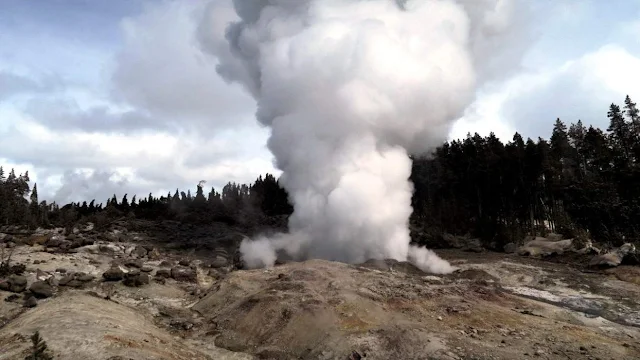World's Tallest Geyser in Yellowstone Erupts for Fifth Time This Year
 |
| Steamboat Geyser is seen in the steam phase of eruption on March 16. The steam phase usually follows a few- to tens-of-minutes water phase and can last for hours to days. |
The Steamboat Geyser at Yellowstone National Park can spout 300 feet of scalding water into the air, a feature of the world’s tallest active geyser. That is known.
What isn’t known is why is the geyser has erupted three times in the past six weeks, including one event on Friday in an unusual pattern that hasn't occurred since 2003.
The spike in activity has puzzled scientists who closely monitor Yellowstone — the crown jewel of the national park system that rests on top of a violent supervolcano measuring 44 miles across.
“There is nothing to indicate that any sort of volcanic eruption is imminent,” Michael Poland, scientist in charge of the observatory, told The Washington Post. The last eruption was 70,000 years ago, and there are no signs of another one, including the recent Steamboat activity, he said Sunday.
Geysers are the result of magma heating water that has seeped into the ground, triggering an eruption of liquid through vents in the earth surface for as long as dozens of minutes, followed by billowing steam that may last days.
#Steamboat #Geyser in @YellowstoneNPS erupts for 5th time in 2018, just before 4 AM on May 13. Steamboat also had frequent eruptions in the 1960s and early 1980s. No implications for volcanic activity, but good implications for viewing some spectauclar geysering this summer! pic.twitter.com/3c4YDcdHyO— USGS Volcanoes🌋 (@USGSVolcanoes) May 13, 2018
Yet geysers are difficult to study. Most have unpredictable eruptions that may happen in intervals lasting years, making it challenging to assign resources such as seismic monitors and cameras, Poland said. For instance, no scientists observed Friday’s eruption. It was reported by a visitor, he said.
One possibility he offered: The three eruptions, on March 15, April 19 and Friday, could point to thermal disturbances — heated ground that can change the behavior of geysers and springs or form new ones, he said.
The string of eruptions over a year in 2003 may have been connected to a particularly violent thermal disturbance that killed trees and nearly boiled trails in the Norris Basin, where several geysers, including Steamboat, are located.
Steamboat has gone dormant for as long as nine years. Its first eruption since 2014 occurred in mid-March, followed by two other eruptions in April and another on May 4.
Earlier this month scientists deployed 28 seismographs around the geyser to gather data in hopes of catching it erupting again to learn more about Steamboat.

%20(1).webp)






